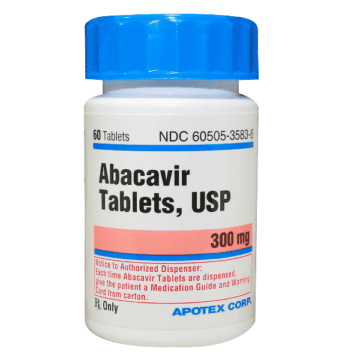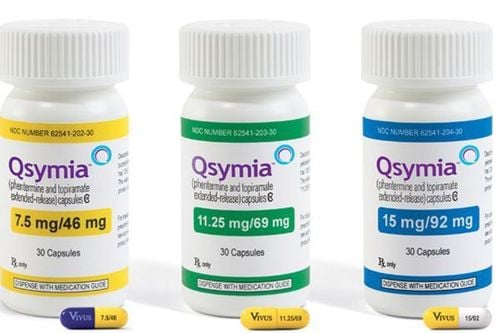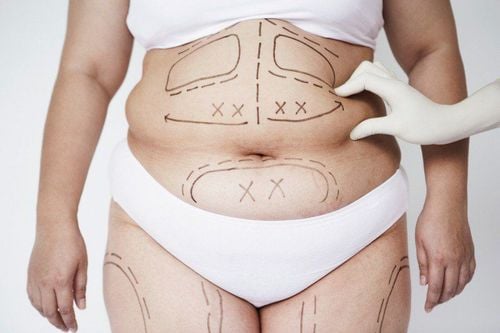This is an automatically translated article.
Weight loss is an essential and urgent need of many people, not only for aesthetic reasons but also related to medical conditions caused by obesity. Abdominal liposuction or weight loss surgery is the choice of those who cannot lose weight through diet and exercise. Choose the type of weight loss surgery that is suitable for the health status, medical history and economic conditions of each person.1. Types of weight loss surgery
Current cosmetic surgeries can help a person lose weight in a variety of ways. Here are the three most common weight loss surgeries:Restrictive surgeries work by shrinking the size of the stomach and slowing down digestion. A normal stomach can hold about 3 liters of food. After surgery, the stomach may initially only hold 30ml, although it may expand to 60 or 90ml later. The smaller the stomach, the less food is consumed. The less you eat, the more weight you lose. Surgery that restricts or makes food absorption more difficult is also used to lose weight. They not only partially shrink the size of the stomach, but also partially eliminate the digestive tract, making it harder for your body to absorb nutrients. Doctors rarely perform total bowel resections because of the serious side effects it brings. An electrical device implanted, the latest of three, helps with weight loss by disrupting nerve signals between the stomach and brain.
2. Gastric tightening surgery
Gastric bypass surgery is a type of restrictive weight loss surgery. The surgeon uses an inflatable wire to squeeze the stomach into two parts: a smaller upper pouch and a larger lower one. These two parts are still connected by a very small channel, which slows down the emptying of the upper pocket. Most people can only eat 1/2 to 1 cup of food before feeling too full or uncomfortable. Food also needs to be processed so that it is soft or chewed thoroughly.Advantage: This operation is simpler and safer than gastrectomy and other types of surgery. The scars that follow are usually smaller, heal faster, and you may have surgery to remove the gastric compression band. You can also adjust the pressure of the band at your doctor's office. To tighten the bandage and further limit the size of your stomach, your doctor will inject more saline solution into the bandage. To loosen it, the doctor uses a needle to remove fluid from the bandage.
Cons: People who undergo this type of surgery often lose significantly more weight than those who choose other types of surgery. However, they may still be more likely to regain the weight years later.
Risks: One of the most common side effects of gastric bypass surgery is vomiting after overeating and eating too quickly. Other complications with the band can also occur such as slipping out of place, becoming too loose, or leaking. Some people need more surgery. As with any other surgical procedure, infection is a type of risk. Some life-threatening complications can occur, although rarely.
3. Sleeve gastrectomy
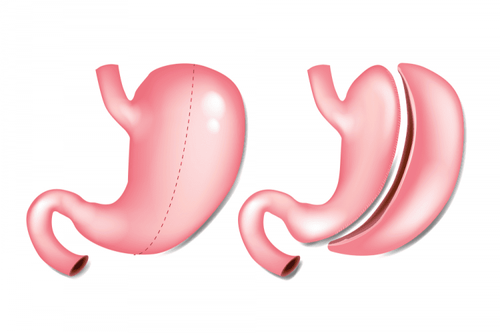
Phẫu thuật cắt dạ dày là một trong những phương pháp giảm cân hạn chế
Pros: For people who are very fat or in poor health, other weight loss surgeries can be too risky. Sleeve gastrectomy is a simpler surgery, giving them a less risky way to lose weight. If needed, when they have lost weight and their health has improved - usually after 12 to 18 months - they can have a second surgery, such as a gastrectomy. Since the intestines are not affected, sleeve gastrectomy does not affect the way your body absorbs food, so you are not susceptible to nutritional deficiencies.
Cons: Unlike gastrectomy, sleeve gastrectomy is irreversible.
Risks: Typical risks include infection, stomach leak and blood clot formation.
4. Roux-en-Y . Gastrectomy
This surgery is a combination of both restrictive and malabsorption approaches. During surgery, the surgeon divides the stomach into two parts, separating the upper part from the lower part. The surgeon then connects the upper part of the stomach directly to the lower part of the small intestine. Essentially, the surgeon is creating a shortcut for food to go down, bypassing part of the stomach and small intestine. Skipping these parts of the digestive tract means the body will absorb fewer calories.Pros: Weight loss tends to appear quick and dramatic. About 50% of them occur in the first 6 months. The weight loss effect can continue for up to 2 years after the operation. Due to rapid weight loss, conditions affected by obesity - such as diabetes, high blood pressure, high cholesterol, arthritis, sleep apnea and heartburn - often improve quickly. Gastrectomy also has good long-term outcomes. Studies have found that many people keep most of their weight stable for 10 years or longer.
Cons: You won't absorb food like you used to and that puts you at risk of not getting enough nutrients. The loss of calcium and iron can lead to osteoporosis and anemia. You will have to be very careful with your diet and taking supplements for the rest of your life. Another risk of gastric bypass is dumping syndrome, in which food empties from the stomach into the intestines too quickly, before being properly digested. About 85% of people who have a gastrectomy experience this syndrome. Symptoms include nausea, bloating, abdominal pain, sweating, weakness, and diarrhea. This syndrome often occurs after eating foods that are sugary or high in carbohydrates, and adjusting your diet can often help. Unlike gastric bypass surgery, gastrectomy is irreversible.
Risks: Because Roux-en-Y gastrectomy is more complicated, the risks are higher. Infection and blood clots can also be complications, as with most other surgeries. Gastrectomy also increases the chance of a hernia, which may require further surgery to correct. In addition, you may develop gallstones because of rapid weight loss.
5. Nerve blockade surgery
An implanted pacemaker-like device sends regular electrical impulses to the vagus nerve, signaling to the brain that the stomach is full. The vagus nerve extends from the brain to the stomach. The blockade device is located under the rib cage and is operated by a remote control that can be adjusted from outside the body.Advantages: This device implantation is the least invasive method of weight loss surgery. The procedure can take up to an hour and a half while the patient is under general anesthesia.
Cons: If the battery runs out, the doctor has to reprogram it. Side effects may include nausea, vomiting, heartburn, difficulty swallowing, belching, and chest pain.
Risks: Infection, pain at the implant site or other surgical complications.
6. Biliopancreatic Diversion
This is a more drastic version of gastrointestinal anastomosis. The surgeon removes up to 70% of your stomach and bypasses more of the small intestine.A simpler version is biliary diversion with duodenal inversion. It's still more impactful than gastrectomy alone, but the procedure removes less of the stomach and bypasses less bowel. Complications such as rapid gastric emptying, malnutrition, and ulcers are less common than standard biliary tract diversion.
Advantages: Biliary diverticulum can reduce weight even more and faster than gastric bypass surgery. Although most of the stomach is removed, what is left is still larger than the pouches left after gastrectomy or ligation. So you may eat more meals with this surgery than with others.
Cons: Biliary bypass surgery is less common than gastrectomy. One of the reasons is that the risk of not getting enough nutrients is much more serious.
Risks: This is one of the most complicated weight loss surgeries and carries the most risks. As with gastrectomy, this surgery carries a fairly high risk of hernia, which will require more surgery to correct. But this risk is lower when the doctor uses a minimally invasive procedure (called laparoscopy).
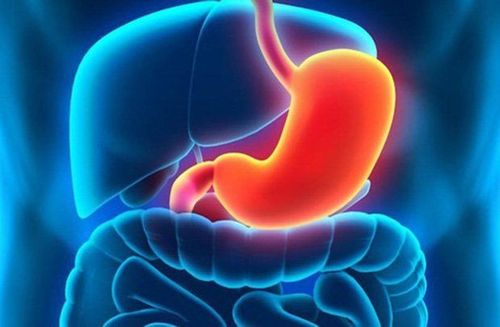
Phẫu thuật chuyển dòng mật tụy sẽ loại bỏ 70% dạ dày và nhiều đoạn ruột non
7. Gastric balloon surgery
Gastric bypass surgery is a type of restrictive weight loss surgery in which a deflated balloon is placed into the stomach through the mouth. When in place, it is filled with a physiological saline solution that gives a feeling of fullness, thereby limiting appetite. Gastric bypass surgery is not for people who have had weight loss surgery or who have bowel disease or liver failure.Advantage: No surgery and no hospital stay. The ball insert is temporary and it can stay in place for six months. A person can lose about 10 percent of their excess body weight during that time.
Cons: Abdominal pain, nausea and vomiting may appear several days after balloon placement.
Risks: The FDA in 2017 reported 5 deaths possibly caused by gastric bypass surgery. Possible causes include gastric perforation, esophageal perforation, or intestinal obstruction. Multiple reports also provide cases of balloon burst and acute pancreatitis caused by balloon pressure on surrounding organs.
8. AspireAssist TM
AspireAssist is a weight loss device that implements the restriction/no absorption principle for weight loss. A tube is placed through a disc-shaped abdominal incision that lies face down on the outside of the abdomen. About 20 - 30 minutes after a meal, the patient attaches the tube to an external drainage device to suck food residue to remove. The device, which was approved by the FDA for weight loss in 2016, is capable of eliminating about 30% of calories consumed.Pros: In a controlled study, patients using AspireAssist lost an average of 12% of their total body weight compared with 3.6% in patients who combined diet and exercise for weight loss. . Another study found that patients lost half their excess weight in 1 year after the device was placed. Intubation can be done quickly, under light sedation.
Cons: As the patient loses weight, the tube and disc need to be adjusted so that the disc remains flat against the skin. Regular follow-up visits with a doctor are also necessary to monitor the device and obtain medical advice. The patient needs to have the drain replaced after a certain number of uses. According to the FDA, side effects include indigestion, nausea, vomiting, constipation, and diarrhea.
Risks: The surgical insertion of the tube can cause sore throat, bloating, bleeding, infection, nausea, pneumonia, and possibly perforation of the stomach or intestines. Patients may experience discomfort, pain, burning, stiffness, or inflammation of the skin around the insertion site. If the tube is removed, it may leave a fistula or an abnormal passage between the stomach and the abdominal wall.
9. Which weight loss surgery is best?

Hãy đảm bảo nơi bạn thực hiện phẫu thuật nổi tiếng và uy tín
For example, if you are obese or if you have had previous abdominal surgery, simpler surgeries may not be possible. Talk to your doctor about the pros and cons of each type of surgery.
If possible, go to a medical center that specializes in weight loss surgery. Studies show that complications are less likely when weight loss surgery is performed by specialists.
No matter where you have surgery, always make sure that your surgeon has extensive experience performing the type of surgery you choose.
Reference source: Webmd.com






